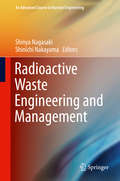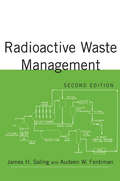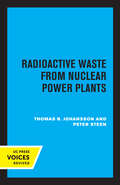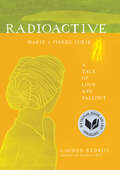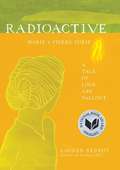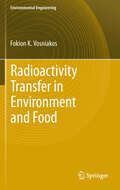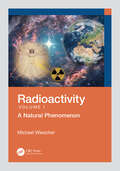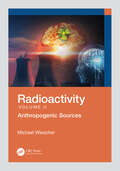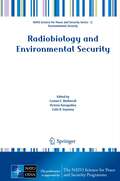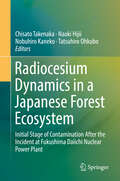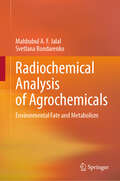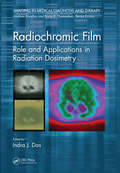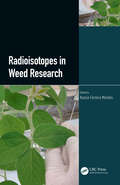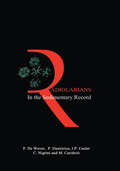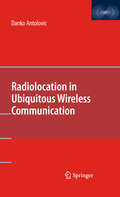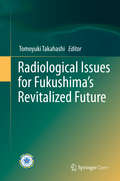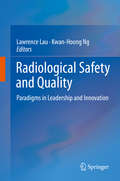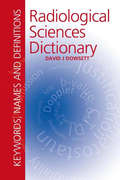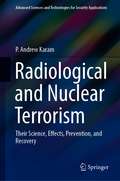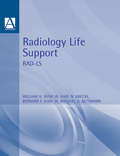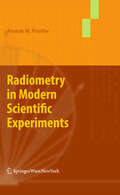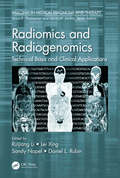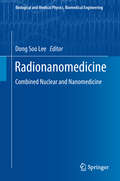- Table View
- List View
Radioactive Waste Engineering and Management
by Shinya Nagasaki Shinichi NakayamaThis book describes essential and effective management for reliably ensuring public safety from radioactive wastes in Japan. This is the first book to cover many aspects of wastes from the nuclear fuel cycle to research and medical use, allowing readers to understand the characterization, treatment and final disposal of generated wastes, performance assessment, institutional systems, and social issues such as intergenerational ethics. Exercises at the end of each chapter help to understand radioactive waste management in context.
Radioactive Waste Management
by James SalingThis reviews sources of radioactive waste and introduces radioactive decay and radiation shielding calculations. It covers technical and regulatory aspects of waste management with discussion questions at the end of each chapter to provide an opportunity to explore the many facets of waste management issues. An extensive reference list at the end of each chapter retains the references from the first edition of the book and incorporates references used in preparing this revised text, giving readers an opportunity to look at historical records as well as current information.
Radioactive Waste from Nuclear Power Plants
by Peter Steen Thomas B. JohanssonThis title is part of UC Press's Voices Revived program, which commemorates University of California Press’s mission to seek out and cultivate the brightest minds and give them voice, reach, and impact. Drawing on a backlist dating to 1893, Voices Revived makes high-quality, peer-reviewed scholarship accessible once again using print-on-demand technology. This title was originally published in 1981.
Radioactive: Marie & Pierre Curie: A Tale of Love and Fallout
by Lauren RednissA visual journey into the life of Marie Curie, as told through the dazzling collage style of acclaimed author and artist Lauren Redniss “Lauren Redniss creates an entirely new genre of biography.” —Nylon“Visually dazzling…a startlingly original graphic style.” —SlateThe name Marie Curie is enshrined in every schoolchild’s mind as one of the earliest and most inspirational female pioneers in the history of science. Yet the rich, vivid, and romantic story of Marya Salome Sklodwska—the young Polish national who discovered radioactivity—has been lost to time . . . until now, in the pages of this stunning, wildly creative, and uniquely moving visual biography by one of the most creative artistic talents working today. Lauren Redniss, a celebrated New York Times illustrator and storyteller, has thrown herself deeply and passionately into researching the story of the real Marie Curie; of her passionate and tragic romantic life; and of the century of scientific innovation and controversy that sprang from her discovery of radium and went on to change the course of world history. Drawing on her original archival research in Europe and the United States—and a host of new interviews with Curie family members and scientists who carry on the Curie tradition—Redniss has created a fascinating and deeply moving book. A visually stunning work of illustrative art, Radioactive walks the reader through the story of Curie’s own life, which was marked by both extraordinary scientific discovery and dramatic personal trauma—from her romantic partnership with Pierre, through his tragic decline from radium poisoning and death in a traffic accident, to the scandalous affair with another fellow scientist that almost cost her her second Nobel Prize. But it also casts an eye forward, to survey the changes wrought by Curie’s discovery of radioactivity—illuminating the path from the Curie laboratory past the bright red mushroom clouds in the Nevada desert through Three Mile Island and the advance in radiation therapy and nuclear power today. Whether young or old, scientific novice or expert, no one will fail to be moved by Lauren Redniss’s eerie and wondrous evocation of one of history’s most intriguing figures.
Radioactive: Marie And Pierre Curie - A Tale Of Love And Fallout
by Lauren RednissIn 1891, 24-year-old Marie Sklodowska moved from Warsaw to Paris, where she found work in the laboratory of Pierre Curie, a scientist engaged in research on heat and magnetism. They fell in love. They took their honeymoon on bicycles. They expanded the periodic table, discovering two new elements with startling properties, radium and polonium. They recognized radioactivity as an atomic property, heralding the dawn of a new scientific era. They won the Nobel Prize. Newspapers mythologized the couple's romance, beginning articles on the Curies with "Once upon a time... " Then, in 1906, Pierre was killed in a freak accident. Marie continued their work alone. She won a second Nobel Prize in 1911, and fell in love again, this time with the married physicist Paul Langevin. Scandal ensued. Duels were fought.<P><P> In the century since the Curies began their work, we've struggled with nuclear weapons proliferation, debated the role of radiation in medical treatment, and pondered nuclear energy as a solution to climate change. In Radioactive, Lauren Redniss links these contentious questions to a love story in 19th Century Paris.<P> Radioactive draws on Redniss's original reporting in Asia, Europe and the United States, her interviews with scientists, engineers, weapons specialists, atomic bomb survivors, and Marie and Pierre Curie's own granddaughter.<P> Whether young or old, scientific novice or expert, no one will fail to be moved by Lauren Redniss's eerie and wondrous evocation of one of history's most intriguing figures.
Radioactivity Transfer in Environment and Food
by Fokion K. VosniakosThe book deals with various consequences of major nuclear accidents, such as in 1986 in Chernobyl and in 2011 in Fukushima. The public is extremely interested in learning more about the movements and risks posed by radiation in the environment related to food supply and food safety. Radionuclides are found in air, water, soil and even in us not only after nuclear accidents because they occur also in nature. Every day, we ingest and inhale radionuclides in our air and food and the water. This book provides a solid underpinning of the basic physical-chemistry and biogeochemistry of naturally occurring and anthrop radioactivity. The mechanisms of radioactive element transfer in the atmosphere, tropospheric and stratospheric diffusion of radioactivity, environmental contamination from accidents and the impact of atmospheric pollution on the food chain, soil and plants, are analyzed and the analytical methods are illustrated. The question of natural radioactivity concentration in building materials is addressed too. While the book contains many case studies and data for Greece, it is of general value. It contributes to the development of international environmentally safe standards and economically reasonable standard regulations based on justified radiological, social and economical legislation concepts.
Radioactivity: A Natural Phenomenon
by Michael WiescherThis book provides an accessible introduction to radioactivity. The first in a two-volume set, this volume is presented in two parts, covering radiation physics and natural radiation exposure.It first explores the discovery and physics of the phenomenon of radioactivity, covering the discovery of radioactive decay and the historical development of the physics and applications of radioactivity through to 1940. Chapters then present descriptive summaries of the physics of the atom and the atomic nucleus, mass and energy conditions, the nature of isotopes, and the different decay patterns. Chapter three discusses decay laws and introduces natural origins of radioactivity as well as methods for producing radioactive isotopes through nuclear reaction processes in reactor and accelerator. The book then provides an introduction on dosimetry, radiation chemistry and impact of radiation on biological systems.The second half of the book details natural radioactivity and the role of radioactivity in the formation of the planetary system and our Earth. The author describes how the inner radioactivity of our planet determines its dynamics and how it could have contributed to the origins of life. The volume concludes with an exploration of the external and internal radioactivity to which humans are exposed and their possible side effects.This book will be of interest to non-science undergraduate and physics graduate students alike, as well as to interested lay-people looking for an introduction to radioactivity. Key Features:- Written in an accessible style, to be understood by readers without a formal scientific education- Highly illustrated throughout- Authored by an expert in the field, drawing from decades of experience in experimental nuclear physics
Radioactivity: Anthropogenic Sources
by Michael WiescherThis book provides an accessible introduction to radioactivity. The second in a two-volume set, this volume is presented in two parts, covering its development and modern applications.It first explores the development and applications of technically enhanced natural radioactivity (TENR) and addresses nuclear energy sources, the fission and fusion processes, and the issues of radioactive fallout from nuclear weapon use and test programs. Later chapters explore the cutting-edge medical applications of radioactive materials in diagnostics and therapy, exploring nuclear medicine technologies such as x-ray tomography, brachytherapy, and positron emission tomography (PET). They also detail the broad range of applications of radioactive materials in industrial production processes, in the sterilization of tools and materials in the medical and the food industries, and in the analysis of art and archaeological material to analyse paintings and painting techniques to identify fakes and forgeries. The book concludes with a discussion of the societal impact and understanding of radioactivity, alongside detailing the underlying reasons for its negative preconceptions and the possible mitigation of these through better education and information practices.This book will be of interest to non-science undergraduate and physics graduate students alike, as well as to interested lay-people looking for an introduction to radioactivity.Key Features:- Written in an accessible style, to be understood by readers without a formal scientific education- Highly illustrated throughout- Authored by an expert in the field, drawing from decades of experience in experimental nuclear physics
Radiobiology and Environmental Security
by Carmel E Mothersill Colin B. Seymour Victoria KorogodinaThis volume - like the NATO Advanced Research Workshop on which it is based - addresses the fundamental science that contributes to our understanding of the potential risks from ecological terrorism, i.e. dirty bombs, atomic explosions, intentional release of radionuclides into water or air. Both effects on human health (DNA and systemic effects) and on ecosystems are detailed, with particular focus on environmentally relevant low-dose ranges. The state-of-the-art contributions to the book are authored by leading experts; they tackle the relevant questions from the perspectives of radiation genetics, radiobiology, radioecology, radiation epidemiology and risk assessment.
Radiocesium Dynamics in a Japanese Forest Ecosystem: Initial Stage of Contamination After the Incident at Fukushima Daiichi Nuclear Power Plant
by Nobuhiro Kaneko Chisato Takenaka Naoki Hijii Tatsuhiro OhkuboThis book investigates radiocesium movement in all major components of forest ecosystems, e.g. the plants, animals, insects, microorganisms, and soils, during the initial stage of contamination after the incident at Fukushima Daiichi Nuclear Power Plant. Most of the work was conducted at a common research site.More specifically, the book examines the contribution of surface uptake by trees in the dynamics of radiocesium during the initial contamination stage; the movement of radiocesium in the form of small organic fragments that are essential to the radiocesium dynamics in forest ecosystems; and the upward movement of radiocesium due to microorganism activity, which promotes the effective decontamination of the forest floor. Lastly, it explains why spiders could be a valuable indicator of the contamination level in forest ecosystems.
Radiochemical Analysis of Agrochemicals: Environmental Fate and Metabolism
by Mahbubul A. Jalal Svetlana BondarenkoThis book provides an in-depth overview of agrochemicals, their development, regulation, and environmental impact. It also offers detailed insights into the latest research methodologies and regulatory standards. Through this comprehensive guide, readers will gain a thorough understanding of the complexities surrounding agrochemical use and its implications for modern agriculture. The chapters cover a wide range of topics including the history and evolution of crop protection methods, the regulatory framework governing agrochemicals, and the intricate processes of degradation and metabolism in various environments. Expert contributors discuss the nuances of radioactivity in agrochemical studies, quantitative and spectroscopic analysis techniques, and the behaviour of these chemicals in soil, water, plants, and livestock. Given its breadth, this book appeals to academics, practitioners, policymakers, and students interested in understanding the scientific principles and practical applications of agrochemicals. Researchers in the fields of agricultural science, environmental chemistry, and regulatory affairs will find this book invaluable.
Radiochromic Film: Role and Applications in Radiation Dosimetry (Imaging in Medical Diagnosis and Therapy)
by Indra J. DasThis book provides a first authoritative text on radiochromic film, covering the basic principles, technology advances, practical methods, and applications. It focuses on practical uses of radiochromic film in radiation dosimetry for diagnostic x-rays, brachytherapy, radiosurgery, external beam therapies (photon, electron, protons), stereotactic body radiotherapy, intensity-modulated radiotherapy, and other emerging radiation technologies. <P><P>The expert authors address basic concepts, advantages, and the main applications including kilovoltage, brachytherapy, megavoltage, electron beam, proton beam, skin dose, in vivo dosimetry, postal and clinical trial dosimetry. The final chapters discuss the state of the art in microbeam, synchrotron radiation, and ultraviolet radiation dosimetry.
Radioisotopes in Weed Research
by Kassio Ferreira MendesHerbicides are of great importance in weed management and are one of the most widely used pesticide groups for weed control across the globe. Concerns around the residual effects of these intensively used chemicals are equally widespread. Offering a new direction for research that focuses on herbicide behavior and its impacts on the environment, this book covers the use of radioisotopes in weed research and the detoxification of herbicides. Applying technological advances in radiation detection, Radioisotopes in Weed Research explains how isotopic techniques can be used to identify degradation products and trace the fate of herbicides applied to crop plants. This book provides essential information on the historical use and recent advances of radioisotopes in weed research. It demonstrates the potential these methods offer the field of weed science in gaining a better understanding of the behavior of herbicides in plants and soil and working to ensure the continuous, effective, and safe use of herbicides, minimizing harmful impacts on ecosystems. Features: Explains the radiometric method with studies of radiolabelled herbicides and includes case studies as examples Describes radiometric methods to study the behavior of herbicides in soil from transport and transformation to retention Elucidates the absorption, translocation, and metabolism studies of herbicides in plants Authored by a team of leading scientists, this book is written for professors, researchers, extensionists, graduate and undergraduate students, rural producers, and other professionals involved in weed science.
Radiolarians in the Sedimentary Record
by P. De Wever P. Dumitrica J.P. Caulet C. Nigrini M. CaridroitRadiolarians in the Sedimentary Record presents the current state of knowledge on fossil radiolarians. The author discusses the record, as well as new integrated taxonomic systems at the family level. The book provides comprehensive coverage of the fossil record of these unicellular organisms. It also discusses their important role in the history o
Radiolocation in Ubiquitous Wireless Communication
by Danko AntolovicThe subject of the book is application of multi-antenna radiolocation to the environment of fast, ubiquitous wireless communication among portable devices. It is a systematic presentation of the author's research and development in the field, within the 802.11b standard, while explaining the general principles and exploring applications to other standards and situations. The purpose is to fill a gap in the current technical literature and present the issues involved in locating mobile wireless network agents, in a single volume, accessible to system designers and other practitioners in the wireless field.
Radiological Issues for Fukushima's Revitalized Future
by Tomoyuki TakahashiThis book overviews environmental issues 4 years after the Fukushima nuclear accident, covering a wide range of areas related to radiation and radioactivity. The topics discussed are necessary to make clear the relationship between the results of research and Fukushima's revitalized future. The chapters are divided into four parts: Part 1 presents the identification of radionuclides in soil and migration of radionuclides in the terrestrial environment; Part 2 describes the safety decontamination system and treatment of radioactive waste; Part 3 explains the development of the system of measurement of environmental radiation and evaluation of external exposure; and Part 4 discusses the identification of radionuclides in farm products, control of root uptake, identification of decreasing radionuclides by food processing, and evaluation of internal exposure. Since the accident at the Tokyo Electric Power Company's Fukushima Daiichi nuclear power station in 2011, gradual steps have been taken toward environmental recovery in the area. However, there are still many issues that need to be tackled in order to achieve the full revitalization of Fukushima. These issues encompass many different disciplines such as economics, psychology, and sociology. In this kind of situation, the role of science in relation to radiation and radioactivity is especially important. This book aims to contribute to planning countermeasures against nuclear disasters in the future. It will be of particular interest to governmental officials who are engaged with the Fukushima nuclear accident; researchers, including those in international sectors, who are interested in radiological issues; and those who need comprehensive and reliable information about the Fukushima accident.
Radiological Safety and Quality
by Lawrence Lau Kwan-Hoong NgThis book is the product of a unique collaboration by experts from leading international, regional and national agencies and professional organizations discussing on the current 'hot' issue on the judicious use and safety of radiation in radiology. There have been several cases involving radiation overexposure that have received international attention. Strategies and solutions to guide readers how to maximize the benefits and minimize the risks when using radiation in medicine are covered.
Radiological Sciences Dictionary: Keywords, names and definitions
by David DowsettThe Radiological Sciences Dictionary is a rapid reference guide for all hospital staff employed in diagnostic imaging, providing definitions of over 3000 keywords as applied to the technology of diagnostic radiology.Written in a concise and easy to digest form, the dictionary covers a wide variety of subject matter, including:a radiation legislati
Radiological and Nuclear Terrorism: Their Science, Effects, Prevention, and Recovery (Advanced Sciences and Technologies for Security Applications)
by P. Andrew KaramThis book discusses multiple aspects of radiological and nuclear terrorism. Do you know what to do if there is a radiological or nuclear emergency in your city? These accidents are not common, but they have happened – and even though we have not seen an attack using these weapons, governments around the world are making plans for how to prevent them – and for how to respond if necessary. Whether you are an emergency responder, a medical caregiver, a public health official – even a member of the public wanting to know how to keep yourself and your loved ones safe – there is a need to understand how these weapons work, how radiation affects our health, how to stop an attack from taking place, how to respond appropriately in the event of an emergency, and much more.Unfortunately, the knowledge that is needed to accomplish all of this is lacking at all levels of society and government. In this book, Dr. Andrew Karam, an internationally respected expert in radiation safety and multiple aspects of radiological and nuclear emergencies, discusses how these weapons work and what they can do, how they can affect our health, how to keep yourself safe, and how to react appropriately whether you are a police officer investigating a suspect radiological weapon, a firefighter responding to a radiological or nuclear attack, a nurse or physician caring for potentially contaminated patients, or a governmental official trying to keep the public safe. To do this, he draws upon his extensive experience in the military, the several years he worked directly with emergency responders, his service on a number of advisory committees, and multiple trips overseas in the aftermath of the Fukushima accident and on behalf of the International Atomic Energy Agency, Interpol, and the Health Physics Society.
Radiology Life Support (RAD-LS): A Practical Approach
by William Bush Jr'Radiology Life Support' focuses on the adverse effects and life-threatening emergencies caused by reactions to the contrast media used in every modern radiology department. Such reactions are relatively infrequent yet can be severe and are therefore difficult to identify and then handle safely without training. All radiologists will experience at least a few such reactions throughout their career. This book teaches proper recognition and treatment of adverse contrast reactions, proper use of sedation and analgesic agents, proper management of an airway in an emergency situation and principle concepts in basic and advanced life support (including early defibrilation). The text is based on the successful training course run by the editors and sponsored by the American Roentgen Ray Society. Adverse reactions to contrast agents are somewhat difficult for physicians without practice to identify and then handle effectively. This volume is a useful aid to the identification process.
Radiometry in Modern Scientific Experiments
by Pravilov AnatolyThe reader is provided with information about methods of calibration of light sources and photodetectors as well as responsiveness of spectral instruments ranging from near infrared to vacuum UV spectral, 1200 - 100 nm, and radiation intensities of up to several quanta per second in absolute and arbitrary units. The author describes for the first time original methods of measurements they created and draws upon over 40 years of experience in working with light sources and detectors to provide accurate and precise measurements. This book is the first to cover these aspects of radiometry and is divided into seven chapters that examine information about terminology, units, light sources and detectors, methods, including author's original ones, of absolute calibration of detectors, spectral instruments responsiveness, absolute measurements of radiation intensity of photoprocesses, and original methods of their study. Of interest to researchers measuring; luminescence spectra, light intensities from IR to vacuum UV, spectral range in wide-light intensity ranges, calibrate light sources and detectors, absolute or relative quantum yields of photoprocess determination.
Radiomics and Radiogenomics: Technical Basis and Clinical Applications (Imaging in Medical Diagnosis and Therapy)
by Ruijiang Li, Lei Xing, Sandy Napel and Daniel L. RubinRadiomics and Radiogenomics: Technical Basis and Clinical Applications provides a first summary of the overlapping fields of radiomics and radiogenomics, showcasing how they are being used to evaluate disease characteristics and correlate with treatment response and patient prognosis. It explains the fundamental principles, technical bases, and clinical applications with a focus on oncology. The book’s expert authors present computational approaches for extracting imaging features that help to detect and characterize disease tissues for improving diagnosis, prognosis, and evaluation of therapy response. This book is intended for audiences including imaging scientists, medical physicists, as well as medical professionals and specialists such as diagnostic radiologists, radiation oncologists, and medical oncologists. Features Provides a first complete overview of the technical underpinnings and clinical applications of radiomics and radiogenomics Shows how they are improving diagnostic and prognostic decisions with greater efficacy Discusses the image informatics, quantitative imaging, feature extraction, predictive modeling, software tools, and other key areas Covers applications in oncology and beyond, covering all major disease sites in separate chapters Includes an introduction to basic principles and discussion of emerging research directions with a roadmap to clinical translation
Radionanomedicine: Combined Nuclear And Nanomedicine (Biological and Medical Physics, Biomedical Engineering)
by Dong Soo LeeThis book describes radionanomedicine as an integrated medicine using exogenous and endogenous This book describes radionanomedicine as an integrated approach that uses exogenous and endogenous nanomaterials for in vivo and human applications. It comprehensively explains radionanomedicine comprising nuclear and nanomedicine, demonstrating that it is more than radionanodrugs and that radionanomedicine also takes advantage of nuclear medicine using trace technology, in which miniscule amounts of materials and tracer kinetic elucidate in vivo biodistribution. It also discusses exogenous nanomaterials such as inorganic silica, iron oxide, upconversion nanoparticles and quantum dots or organic liposomes labelled with radioisotopes, and radionanomaterials used for targeted delivery and imaging for theranostic purposes. Further, it examines endogenous nanomaterials i.e. extracellular vesicles labelled with radioisotopes, known as radiolabelled extracellular vesicles, as well as positron emission tomography (PET) and single photon emission computed tomography (SPECT), which elucidate the biodistribution and potential for therapeutic success.
Radionuclide Concentrations in Food and the Environment
by Leo M. L. Nollet Michael PoschlAs radiological residue, both naturally occurring and technologically driven, works its way through the ecosystem, we see its negative effects on the human population. Radionuclide Concentrations in Food and the Environment addresses the key issues concerning the relationship between natural and manmade sources of environmental radioactivity
Radionuclide Contamination and Remediation Through Plants
by Clemens Walther Dharmendra Kumar GuptaThis book focuses on the mechanistic (microscopic) understanding of radionuclide uptake by plants in contaminated soils and potential use of phytoremediation. The key features concern radionuclide toxicity in plants, how the radioactive materials are absorbed by plants, and how the plants cope with the toxic responses. The respective chapters examine soil classification, natural plant selection, speciation of actinides, kinetic modeling, and case studies on cesium uptake after radiation accidents. Radionuclide contaminants pose serious problems for biological systems, due to their chemical toxicity and radiological effects. The processes by which radionuclides can be incorporated into vegetation can either originate from activity interception by external plant surfaces (either directly from the atmosphere or from resuspended material), or through uptake of radionuclides via the root system. Subsequent transfer of toxic elements to the human food chain is a concrete danger. Therefore, the molecular mechanisms and genetic basis of transport into and within plants needs to be understood for two reasons: The effectiveness of radionuclide uptake into crop plants - so-called transfer coefficient - is a prerequisite for the calculation of dose due to the food path. On the other hand, efficient radionuclide transfer into plants can be made use of for decontamination of land - so-called phytoremediation, the direct use of living, green plants for in situ removal of pollutants from the environment or to reduce their concentrations to harmless levels.
